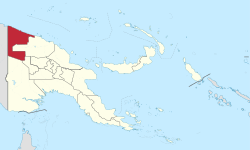Sandaun Province
Sandaun Province (formerly West Sepik Province) is the north-westernmost province of Papua New Guinea. It covers an area of 35,920 km² and has a population of 248,411 (2011 census). The capital is Vanimo. In July 1998 the area surrounding the town Aitape was hit by an enormous tsunami caused by a Magnitude 7.0 earthquake which killed over 2,000 people. The five villages along the west coast of Vanimo towards the International Border are namely; Lido, Waromo, Yako, Musu and Wutung.
Sandaun Province | |
|---|---|
| West Sepik Province | |
 Flag | |
 Sandaun Province in Papua New Guinea | |
| Coordinates: 3°40′S 141°30′E | |
| Country | Papua New Guinea |
| Capital | Vanimo |
| Districts | |
| Government | |
| • Governor | Tony Wouwou (2018-Present) |
| Area | |
| • Total | 35,820 km2 (13,830 sq mi) |
| Population (2011 census) | |
| • Total | 248,411 |
| • Density | 6.9/km2 (18/sq mi) |
| Time zone | UTC+10 (AEST) |
| HDI (2018) | 0.518[1] low · 17th of 22 |
Name
Sandaun is a Tok Pisin word derived from English "sun down," since the province is located in the west of the country, where the sun sets.[2]
Districts and LLGs
There are four districts in the province. Each district has one or more Local Level Government (LLG) areas. For census purposes, the LLG areas are subdivided into wards and those into census units.[3][4][5]
Provincial leaders
The province was governed by a decentralised provincial administration, headed by a Premier, from 1978 to 1995. Following reforms taking effect that year, the national government reassumed some powers, and the role of Premier was replaced by a position of Governor, to be held by the winner of the province-wide seat in the National Parliament of Papua New Guinea.[6][7]
Premiers (1978–1995)
| Premier | Term |
|---|---|
| Jacob Talis | 1978–1980 |
| Adam Amod | 1980–1982 |
| Andrew Komboni | 1982–1984 |
| Paul Langro | 1984–1987 |
| provincial government suspended | 1987–1988 |
| Egbert Yalu | 1988–1992 |
| Aloitch Peien | 1993–1995 |
Governors (1995–present)
| Premier | Term |
|---|---|
| John Tekwie | 1995–2000 |
| Robert Sakias | 2000–2002 |
| Carlos Yuni | 2002–2007 |
| Simon Solo | 2007–2012 |
| Amkat Mai | 2012–2013, 2015–2017 |
| Tony Wouwou | 2017–present |
Members of the National Parliament
The province and each district is represented by a Member of the National Parliament. There is one provincial electorate and each district is an open electorate.
| Premier | Term |
|---|---|
| West Sepik Provincial | Tony Wouwou |
| Aitape-Lumi Open | Patrick Pruaitch |
| Nuku Open | Joe Sungi |
| Telefomin Open | Solan Mirisim |
| Vanimo-Green River Open | Belden Namah |
References
- "Sub-national HDI - Area Database - Global Data Lab". hdi.globaldatalab.org. Retrieved 2020-04-18.
- Statoids - Papua New Guinea Provinces
- National Statistical Office of Papua New Guinea
- "Final Figures". www.nso.gov.pg. 2011 National Population and Housing Census: Ward Population Profile. Port Moresby: National Statistical Office, Papua New Guinea. 2014.
- "Census Figures by Wards - Momase Region". www.nso.gov.pg. 2011 National Population and Housing Census: Ward Population Profile. Port Moresby: National Statistical Office, Papua New Guinea. 2014.
- May, R. J. "8. Decentralisation: Two Steps Forward, One Step Back". State and society in Papua New Guinea: the first twenty-five years. Australian National University. Retrieved 31 March 2017.
- "Provinces". rulers.org. Retrieved 31 March 2017.